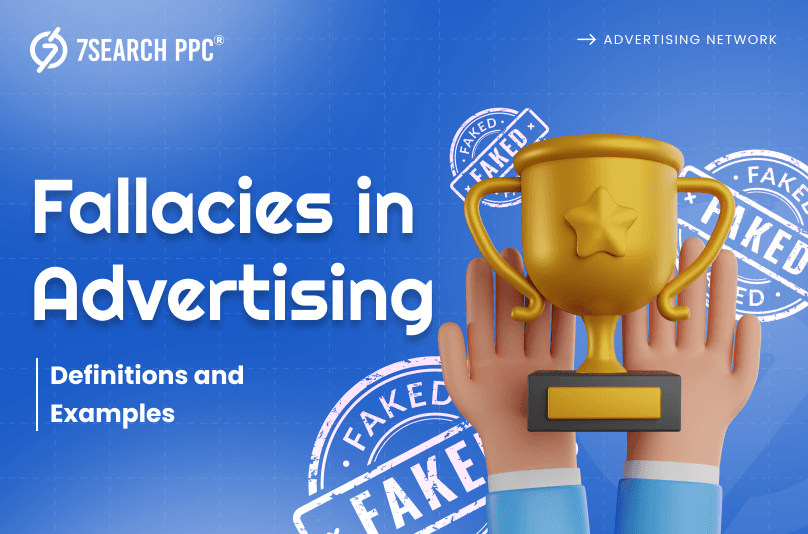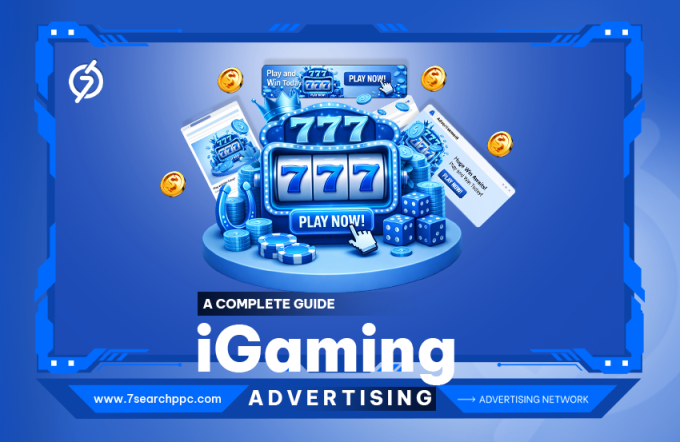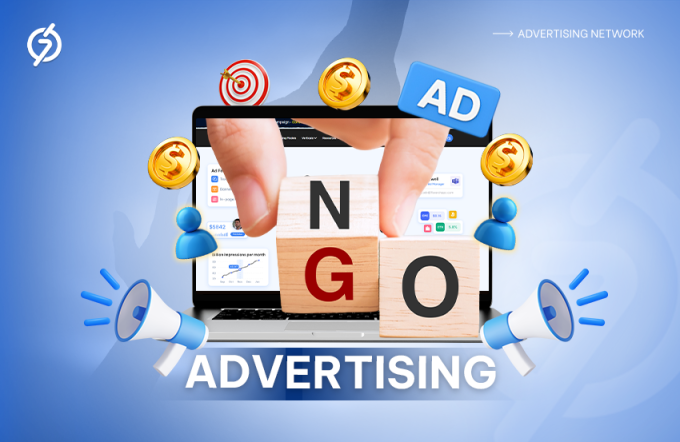Sir, Consider purchasing this product as it holds the number one rank in this industry. You often hear this type of line from salespersons or through online ads. This is a smart tactic businesses use to show their offerings as superior to competitors.
Look, there are more than 334 million (approx.) companies globally, and all of them are showing advertisements through various advertising channels, but the competition is so fierce that they can’t stick to a single strategy. They always wonder how to convey their message to their targeted audience at the right time. Fallacies in advertising are one of them.
What is this tactic all about?
Does this tactic always work?
Why is it important for marketers to understand the common advertising fallacies in this competitive landscape?
All questions are valid, and we know that you also want this answer, right? In this blog, we will examine these questions and also tell you the hidden insights that you might be unaware of. So, let’s start this blog.
Fallacies In Advertising: How Do They Impact Perceptions
Advertising fallacies are deceptive tactics that manipulate consumers’ perceptions and beliefs about a product or service. Common fallacies include false analogies, where irrelevant similarities are drawn between products, and ad hominem attacks, targeting competitors rather than focusing on the merits of the advertised item.
Additionally, appeals to authority, emotions, or popularity are often employed to sway consumer opinions.

These fallacies exploit cognitive biases and logical errors to persuade rather than inform. Sometimes, these tactics work well for businesses but not for the long term. They damage the brand’s reputation more than they benefit it. The use of this tactic may be intentional or unintentional, but overall, it declines the customer’s trust in the brand.
Why Advertisers Use Fallacies In Advertising: Deception or Strategy?
As we discussed above, fallacies in advertising are one tactic advertisers use to grow their sales and profits. They employ a team solely dedicated to capturing customer’s attention through misleading fallacies. They often use fallacy advertising strategies to persuade potential customers to buy their products, even if they might not be the best choice.
These fallacies can be emotional appeals, such as making you feel happy or creating FOMO(fear of missing out) to influence your decisions. They might oversimplify things, making a product seem amazing, but the actual reality is often quite different from what is promised in the advertisement.
By using these tactics, advertisers are hoping to convince you to purchase something that you may not have considered otherwise.
Here Is The Conclusion
It can be concluded that the use of fallacies in advertising can serve as a combination of deceptive and strategic tactics. At the same time, some advertisers may use fallacies to deceive consumers. Some may utilize them in a strategic manner to increase the effectiveness of their advertising campaigns.
Top 5 Reasons Why Advertisers Use Fallacies In Advertising
Advertisers often use fallacies to manipulate consumer perceptions and behaviors.
We have researched the top five reasons that clarify why they employ fallacies in their ad campaigns;
- Grab Attention and Persuade- If the advertisers get positive results from just showing the product description to customers, then what is the use of fallacies in advertising? It’s not enough to rely on logic and facts when convincing the audience to buy a product. Advertising fallacies can be more effective as they tap into emotions or a sense of urgency.
- Emotional Manipulation- Advertisers who use fallacies in their ad campaigns can positively influence consumer perception and decision-making. It can be used to evoke strong emotional responses that influence consumer behavior and connect those feelings with the product.
- Oversimplification- Some products or services have complex features or benefits that can be challenging to explain in a simple way. Advertisers often use fallacies to make these hard concepts more simple and appealing to a broader audience. For example, they might use a false analogy to make a product seem more relatable and desirable, even if the comparison does not make logical sense.
- Brand Image- A well-crafted fallacy ad can leave a lasting impression on audiences. Even if the logic is inaccurate, the memorable slogans or catchy visuals might stick in the audience’s minds and create a stronger brand association. And you know that if the advertiser gets successful in pasting their brand image in customers’ minds, their half work is already done in shaping consumer perceptions.
- Social Pressure- It happened with all of us that we used to buy a particular product or service because of the social pressure we get after seeing an advertisement. This type of pressure is generated by advertisers through bandwagon ads that can make people feel like they need a product or service because everyone is using it. This creates a sense of FOMO and social pressure to conform.
Types Of Fallacies In Advertising
There are various fallacies in advertising we’ve experienced in our daily lives.
Here are some of the common types of fallacies used in advertising;
Appeal To Authority
Appeal to authority is a type of fallacy that suggests that a product or service is superior because it is used by a famous person or expert. However, it is important to note that success or knowledge in one particular field does not necessarily make one an expert in another field. Thus, just because a famous person endorses a product or service, it does not necessarily mean that it is the best option for you. This fallacy suggests that a particular product or service is better because a famous personality or expert endorses it.
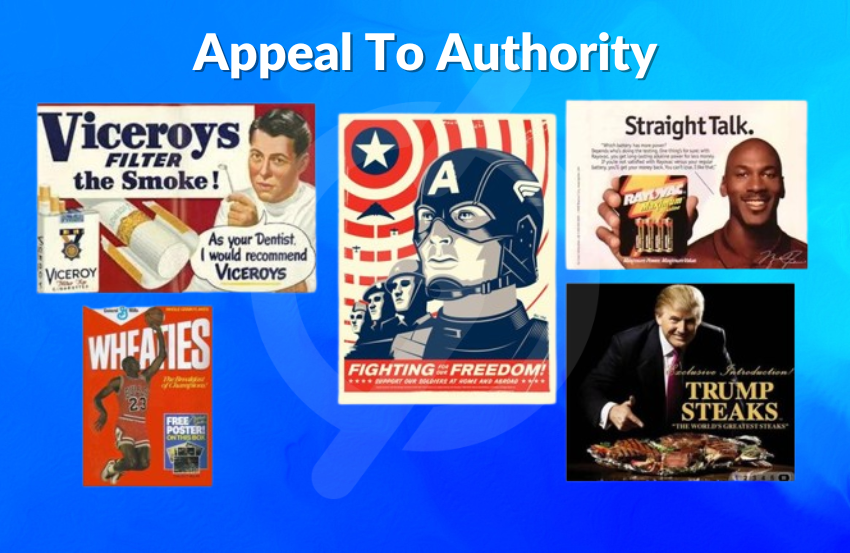
An example of an Appeal To Authority: An advertisement that shows a celebrity promoting a protein powder of a particular brand by making a claim that this protein powder is the best for building muscles. It can influence people’s decision to purchase the product based on their fame and not on scientific evidence of its effectiveness.
Bandwagon Fallacy
A bandwagon is also one of the fallacies in advertising that convinces you to buy a product because everyone else is buying it. It creates a sense of social pressure and encourages you to purchase the product or service due to its high popularity among others.
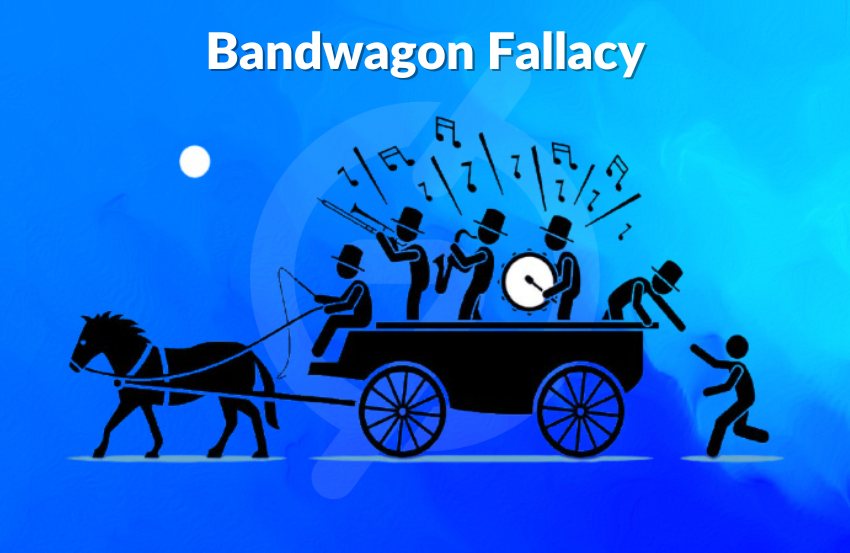
An example of a Bandwagon Fallacy: The famous automobile brand Suzuki usually shows in its advertisements that millions of people are choosing their bikes, so you should, too. This ad is counted under the bandwagon fallacy because it overlooks the need for individual evaluation and critical thinking in decision-making.
False Dilemma Fallacy
The false dilemma fallacy is a misleading advertising approach that presents a situation as having only two options when, in reality, there are more possibilities available.
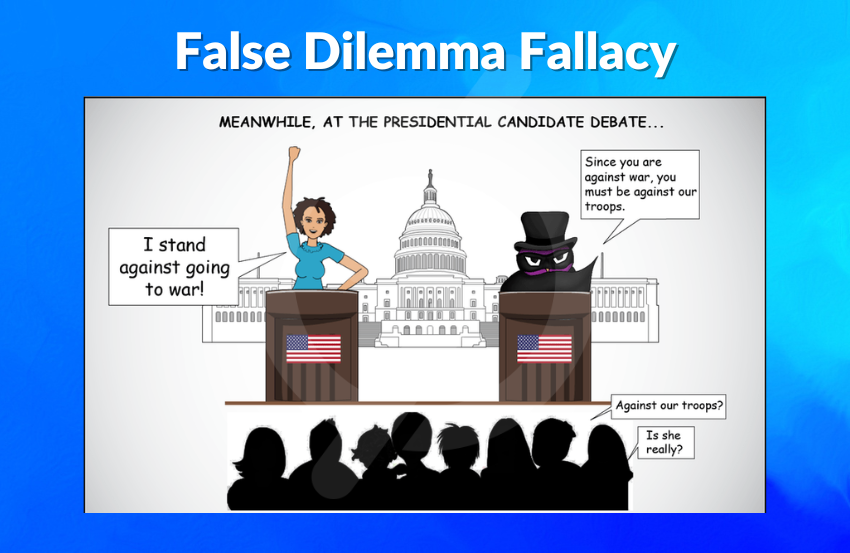
An example of a False Dilemma Fallacy: A common example of a false dilemma fallacy in advertising is the promotion of cleaning products such as bathroom cleaners. Advertisers often present their product as the only solution for cleaning bathrooms, which implies that consumers must choose between their brand and a dirty bathroom. This oversimplification ignores alternative cleaning methods or products, creating a false sense of necessity for their specific brand.
Slippery Slope Fallacy
Advertising often employs the slippery slope fallacy to manipulate consumers into purchasing their products. They make exaggerated claims like “If you don’t use X brand toothpaste, you will lose your teeth.” Advertisers use fear tactics to pressure consumers and manipulate them to buy the products or services, even when it is not truly essential.
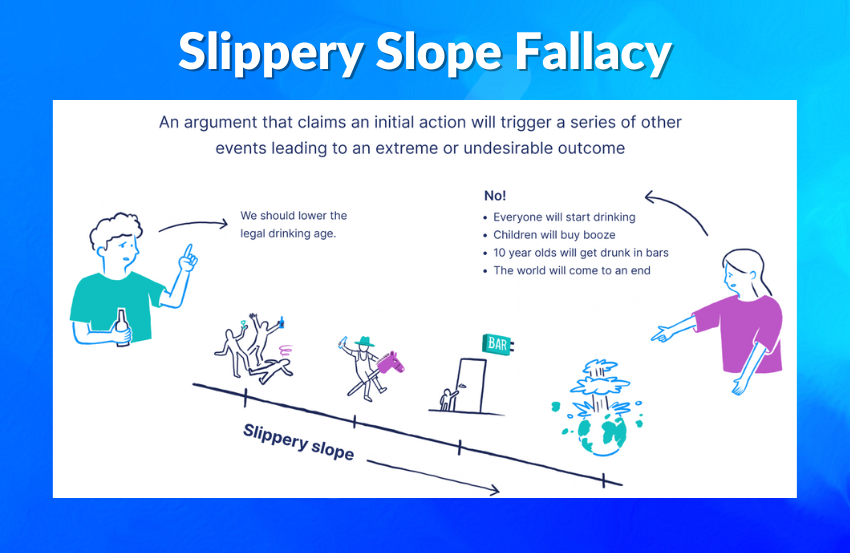
An example of a Slippery Slope Fallacy: An ad that shows its fairness cream for men with a tagline, “If you don’t use our fairness cream, you will never get a date.” such statements come under fallacies in advertising which are untrue and play on people’s emotions and fears.
Ad Hominem
Ad hominem advertising is the act of attacking a rival brand’s products in terms of its features or characteristics. It doesn’t limit itself just to the product but also involves undermining the traits of the spokespeople or celebrities endorsing it.
Staying true to its Latin translation, ‘against the person,’ such ads undermine and badmouth competitor brands, presenting them as unworthy to consumers. This is simply a diversion tactic used by advertisers where they fail to mention any factual evidence as to why their products are superior.
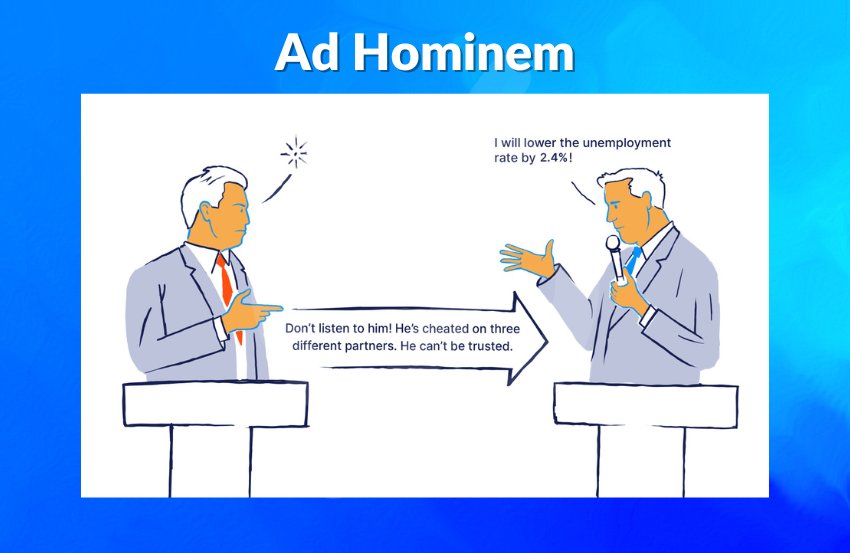
Examples of Ad Hominem:
Example 1. A soft drink commercial that mocks consumers’ intelligence or choices who prefer a competing brand rather than highlighting the taste or quality of their own product.
Example 2. Apple’s ‘Get a Mac’ TV campaign launched in 2006 is the best example of ad hominem. The ad portrays two guys representing Mac and PC, where PC’s character is depicted as dimwitted. It focuses on the hassles of having a PC without highlighting any of its own features.
Conclusion
Fallacies in advertising may attract attention and increase sales in the short term. But they can harm a brand’s reputation in the long run. Advertisers often use fallacies to manipulate emotions, create a false sense of urgency, or oversimplify complex features.
Some common examples of fallacies in advertising include appeals to authority, bandwagon effects, and false dilemmas. By understanding these fallacies, consumers can make informed choices, and advertisers can build trust by using honest marketing practices.
Frequently Asked Questions (FAQs)
What is an example of a fallacy in an advertisement?
Ans. There are many fallacies used in advertising, but a common one is the bandwagon fallacy. It convinces people to buy a product by claiming that everyone else is buying it.
What is this tactic all about?
Ans. The tactic is about using deceptive or misleading methods, known as fallacies, in advertising to influence consumers’ perceptions and decisions. These fallacies can include drawing false comparisons, making emotional appeals, or using the popularity of a product to convince people to buy it.
Essentially, it’s about tricking people into believing that a product is better than it actually is by playing on their cognitive biases and logical errors.
Does this tactic always work?
Ans. No, this tactic does not always work. While it can sometimes be effective in the short term by grabbing attention and persuading people to make a purchase, it often backfires in the long run. When consumers realize they have been misled, they lose trust in the brand. This can harm the brand’s reputation and lead to a decrease in customer loyalty.
Why is it important for marketers to understand the common advertising fallacies in this competitive landscape?
Ans. It is important for marketers to understand common advertising fallacies is crucial for marketers in today’s competitive market. It helps them maintain consumer trust, develop effective strategies, ensure compliance with regulations, and gain a competitive edge through transparency.
How do fallacies affect advertising?
Ans. Fallacies in advertising can mislead consumers by making illogical claims or appealing to emotions rather than real facts. It can create unrealistic expectations about a product’s benefits, which can lead to poor purchasing decisions.
What should advertisers do to avoid fallacies in advertising?
Ans. Advertisers should use some strategies to avoid fallacies in advertising, such as ensuring their ads are truthful, transparent, and based on factual information rather than relying on misleading tactics to convince audiences.
What is the false cause fallacy that appears in advertising?
Ans. The false cause fallacy in advertising occurs when a product is falsely linked to a desired outcome without sufficient evidence of causation. We’ve experienced this fallacy mainly in beauty product ads.
How can I identify fallacies in advertising?
Ans. You can identify fallacies in advertising by examining emotional messages, vague language, and the absence of credible sources.

